View in other NatureServe Network Field Guides
NatureServe
Montana
Utah
Wyoming
Idaho
Wisconsin
British Columbia
South Carolina
Yukon
California
New York
Double-crested Cormorant - Nannopterum auritum
Other Names:
Phalacrocorax auritus
Native Species
Global Rank:
G5
State Rank:
S5B
(see State Rank Reason below)
Agency Status
USFWS:
MBTA
USFS:
BLM:
PIF:
External Links
State Rank Reason (see State Rank above)
Species is relatively common within suitable habitat and widely distributed across portions of the state.
General Description
Large, dark cormorant. Typical length 70 to 90cm, body mass 1.2 to 2.5 kg. Sexes are alike. Males are slightly larger than females. Adults have black or dark-brown plumage, with a dull greenish or bronze gloss. The orange-yellow skin of face and throat is distinctive throughout the year. The "double crest" feathers are variable and are fully developed for only a short time early in the year. This is the only seasonal change. Has totipalmate feet in which all 4 toes are connected by web (Hatch and Weseloh 1999).
For a comprehensive review of the conservation status, habitat use, and ecology of this and other Montana bird species, please see
Marks et al. 2016, Birds of Montana.Species Range
Montana Range
Range Descriptions
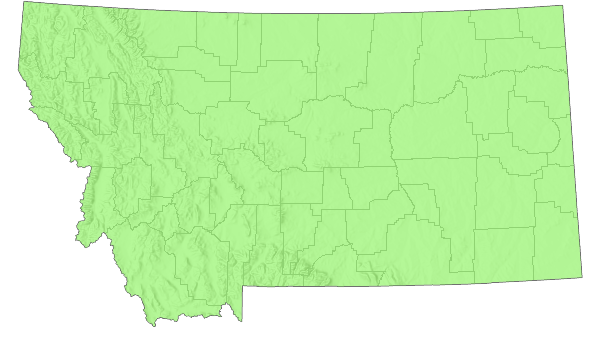 Western Hemisphere Range
Western Hemisphere Range

Observations in Montana Natural Heritage Program Database
Number of Observations: 9962
(Click on the following maps and charts to see full sized version)
Map Help and Descriptions
Relative Density
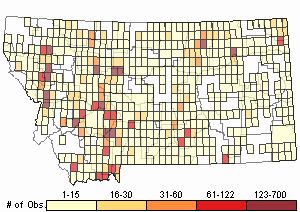
Recency
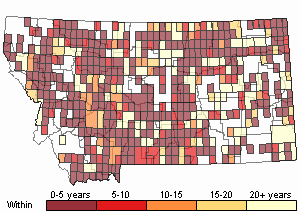
SUMMER (Feb 16 - Dec 14)
Direct Evidence of Breeding

Indirect Evidence of Breeding

No Evidence of Breeding

WINTER (Dec 15 - Feb 15)
Regularly Observed

Not Regularly Observed

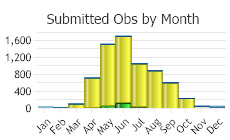

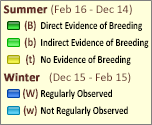 (Observations spanning multiple months or years are excluded from time charts)
(Observations spanning multiple months or years are excluded from time charts)
Migration
Birds breeding east of the Rocky Mountains generally winter along the Gulf of Mexico from Florida to Texas (Dolbeer 1991). In the Bozeman area they are seen during spring migration from April 10 to May 30 and intermittently from July to October 10, with a peak in the fall around September 6.
Habitat
Occupies diverse aquatic habitats in all seasons. Requires, in addition to feeding habitats, suitable places for daytime resting or loafing and nighttime roosts (Hatch and Weseloh 1999).
Ecological Systems Associated with this Species
- Details on Creation and Suggested Uses and Limitations
How Associations Were Made
We associated the use and habitat quality (common or occasional) of each of the 82 ecological systems mapped in Montana for
vertebrate animal species that regularly breed, overwinter, or migrate through the state by:
- Using personal observations and reviewing literature that summarize the breeding, overwintering, or migratory habitat requirements of each species (Dobkin 1992, Hart et al. 1998, Hutto and Young 1999, Maxell 2000, Foresman 2012, Adams 2003, and Werner et al. 2004);
- Evaluating structural characteristics and distribution of each ecological system relative to the species' range and habitat requirements;
- Examining the observation records for each species in the state-wide point observation database associated with each ecological system;
- Calculating the percentage of observations associated with each ecological system relative to the percent of Montana covered by each ecological system to get a measure of "observations versus availability of habitat".
Species that breed in Montana were only evaluated for breeding habitat use, species that only overwinter in Montana were only evaluated for overwintering habitat use, and species that only migrate through Montana were only evaluated for migratory habitat use.
In general, species were listed as associated with an ecological system if structural characteristics of used habitat documented in the literature were present in the ecological system or large numbers of point observations were associated with the ecological system.
However, species were not listed as associated with an ecological system if there was no support in the literature for use of structural characteristics in an ecological system,
even if point observations were associated with that system.
Common versus occasional association with an ecological system was assigned based on the degree to which the structural characteristics of an ecological system matched the preferred structural habitat characteristics for each species as represented in scientific literature.
The percentage of observations associated with each ecological system relative to the percent of Montana covered by each ecological system was also used to guide assignment of common versus occasional association.
If you have any questions or comments on species associations with ecological systems, please contact the Montana Natural Heritage Program's Senior Zoologist.
Suggested Uses and Limitations
Species associations with ecological systems should be used to generate potential lists of species that may occupy broader landscapes for the purposes of landscape-level planning.
These potential lists of species should not be used in place of documented occurrences of species (this information can be requested at:
mtnhp.mt.gov/requests) or systematic surveys for species and evaluations of habitat at a local site level by trained biologists.
Users of this information should be aware that the land cover data used to generate species associations is based on imagery from the late 1990s and early 2000s and was only intended to be used at broader landscape scales.
Land cover mapping accuracy is particularly problematic when the systems occur as small patches or where the land cover types have been altered over the past decade.
Thus, particular caution should be used when using the associations in assessments of smaller areas (e.g., evaluations of public land survey sections).
Finally, although a species may be associated with a particular ecological system within its known geographic range, portions of that ecological system may occur outside of the species' known geographic range.
Literature Cited
- Adams, R.A. 2003. Bats of the Rocky Mountain West; natural history, ecology, and conservation. Boulder, CO: University Press of Colorado. 289 p.
- Dobkin, D. S. 1992. Neotropical migrant land birds in the Northern Rockies and Great Plains. USDA Forest Service, Northern Region. Publication No. R1-93-34. Missoula, MT.
- Foresman, K.R. 2012. Mammals of Montana. Second edition. Mountain Press Publishing, Missoula, Montana. 429 pp.
- Hart, M.M., W.A. Williams, P.C. Thornton, K.P. McLaughlin, C.M. Tobalske, B.A. Maxell, D.P. Hendricks, C.R. Peterson, and R.L. Redmond. 1998. Montana atlas of terrestrial vertebrates. Montana Cooperative Wildlife Research Unit, University of Montana, Missoula, MT. 1302 p.
- Hutto, R.L. and J.S. Young. 1999. Habitat relationships of landbirds in the Northern Region, USDA Forest Service, Rocky Mountain Research Station RMRS-GTR-32. 72 p.
- Maxell, B.A. 2000. Management of Montana's amphibians: a review of factors that may present a risk to population viability and accounts on the identification, distribution, taxonomy, habitat use, natural history, and the status and conservation of individual species. Report to U.S. Forest Service Region 1. Missoula, MT: Wildlife Biology Program, University of Montana. 161 p.
- Werner, J.K., B.A. Maxell, P. Hendricks, and D. Flath. 2004. Amphibians and reptiles of Montana. Missoula, MT: Mountain Press Publishing Company. 262 p.
Food Habits
At most sites eats almost entirely fish preferring slow-moving or schooling species. (Hatch and Weseloh 1999).
Reproductive Characteristics
Typically a single brood. Second broods per season are rare. Clutch size is 1 to 7 eggs with 4 being normal. Nesting is done in colonies (Hatch and Weseloh 1999). Nesting occurs in late May to early June.
Stewardship Responsibility
References
- Literature Cited AboveLegend:
 View Online Publication
View Online Publication Dolbeer, R.A. 1991. Migration patterns of Double-crested Cormorants east of the Rocky Mountains. Journal of Field Ornithology 62(1):83-93.
Dolbeer, R.A. 1991. Migration patterns of Double-crested Cormorants east of the Rocky Mountains. Journal of Field Ornithology 62(1):83-93. Marks, J.S., P. Hendricks, and D. Casey. 2016. Birds of Montana. Arrington, VA. Buteo Books. 659 pages.
Marks, J.S., P. Hendricks, and D. Casey. 2016. Birds of Montana. Arrington, VA. Buteo Books. 659 pages.
- Additional ReferencesLegend:
 View Online Publication
View Online Publication
Do you know of a citation we're missing? American Ornithologists’ Union [AOU]. 1998. Check-list of North American birds, 7th edition. American Ornithologists’ Union, Washington, D.C. 829 p.
American Ornithologists’ Union [AOU]. 1998. Check-list of North American birds, 7th edition. American Ornithologists’ Union, Washington, D.C. 829 p. Bramblett, R.G., and A.V. Zale. 2002. Montana Prairie Riparian Native Species Report. Montana Cooperative Fishery Research Unit, Montana State University - Bozeman.
Bramblett, R.G., and A.V. Zale. 2002. Montana Prairie Riparian Native Species Report. Montana Cooperative Fishery Research Unit, Montana State University - Bozeman. Cameron, E. S. 1907. The birds of Custer and Dawson counties, Montana. Auk 24(3): 241-270.
Cameron, E. S. 1907. The birds of Custer and Dawson counties, Montana. Auk 24(3): 241-270. Carlsen, T. and R. Northrup. 1992. Canyon Ferry Wildlife Management Area Final Draft Management Plan. March 1992.
Carlsen, T. and R. Northrup. 1992. Canyon Ferry Wildlife Management Area Final Draft Management Plan. March 1992. Casey, D. 2005. Rocky Mountain Front avian inventory. Final report. Prepared for the U.S. Fish and Wildlife Service and The Nature Conservancy by the American Bird Conservancy, Kalispell, Montana.
Casey, D. 2005. Rocky Mountain Front avian inventory. Final report. Prepared for the U.S. Fish and Wildlife Service and The Nature Conservancy by the American Bird Conservancy, Kalispell, Montana. Confluence Consulting Inc. 2010. Montana Department of Transportation Wetland Mitigation Monitoring Reports (various sites). MDT Helena, MT.
Confluence Consulting Inc. 2010. Montana Department of Transportation Wetland Mitigation Monitoring Reports (various sites). MDT Helena, MT. Confluence Consulting Inc. 2011. Montana Department of Transportation Wetland Mitigation Monitoring Reports (various sites). MDT Helena, MT.
Confluence Consulting Inc. 2011. Montana Department of Transportation Wetland Mitigation Monitoring Reports (various sites). MDT Helena, MT. Conniff, R. 1991. Why catfish farmers want to throttle the crow of the sea. Smithsonian. July 1991. pp. 44-50, 52, 54-55.
Conniff, R. 1991. Why catfish farmers want to throttle the crow of the sea. Smithsonian. July 1991. pp. 44-50, 52, 54-55. Dood, A.R. 1980. Terry Badlands nongame survey and inventory final report. Montana Department of Fish, Wildlife, and Parks and Bureau of Land Management, Helena, MT. 70 pp.
Dood, A.R. 1980. Terry Badlands nongame survey and inventory final report. Montana Department of Fish, Wildlife, and Parks and Bureau of Land Management, Helena, MT. 70 pp. Ehrlich, P., D. Dobkin, and D. Wheye. 1988. The birder’s handbook: a field guide to the natural history of North American birds. Simon and Schuster Inc. New York. 785 pp.
Ehrlich, P., D. Dobkin, and D. Wheye. 1988. The birder’s handbook: a field guide to the natural history of North American birds. Simon and Schuster Inc. New York. 785 pp. Feigley, H. P. 1997. Colonial nesting bird survey on the Bureau of Land Management Lewistown District: 1996. Unpublished report, U.S. Bureau of Land Management, Lewistown, Montana.
Feigley, H. P. 1997. Colonial nesting bird survey on the Bureau of Land Management Lewistown District: 1996. Unpublished report, U.S. Bureau of Land Management, Lewistown, Montana. Gniadek, S. 1983. Southwest Glendive Wildlife Baseline Inventory. Miles City, Mont: Bureau of Land Management, Miles City District Office. 56 pp with appendices.
Gniadek, S. 1983. Southwest Glendive Wildlife Baseline Inventory. Miles City, Mont: Bureau of Land Management, Miles City District Office. 56 pp with appendices. Goodell, J. 2012. Morse Land Company Breeding Bird Inventory And Analysis. High Desert Museum. Bend, OR. 42 pp + Appendices.
Goodell, J. 2012. Morse Land Company Breeding Bird Inventory And Analysis. High Desert Museum. Bend, OR. 42 pp + Appendices. Hatch, Jeremy J., and D. V. Weseloh. 2004. Double-crested Cormorant (Phalacrocorax auritus). Species Account Number 441. The Birds of North America Online (A. Poole, Ed.). Ithaca, NY: Cornell Laboratory of Ornithology; Retrieved 3/25/2008 from The Birds of North America Online database
Hatch, Jeremy J., and D. V. Weseloh. 2004. Double-crested Cormorant (Phalacrocorax auritus). Species Account Number 441. The Birds of North America Online (A. Poole, Ed.). Ithaca, NY: Cornell Laboratory of Ornithology; Retrieved 3/25/2008 from The Birds of North America Online database Hays, R., R.L. Eng, and C.V. Davis (preparers). 1984. A list of Montana birds. Helena, MT: MT Dept. of Fish, Wildlife & Parks.
Hays, R., R.L. Eng, and C.V. Davis (preparers). 1984. A list of Montana birds. Helena, MT: MT Dept. of Fish, Wildlife & Parks. Hoffmann, R.S., R.L. Hand, and P.L. Wright. 1959. Recent bird records from western Montana. The Condor 61(2):147-151.
Hoffmann, R.S., R.L. Hand, and P.L. Wright. 1959. Recent bird records from western Montana. The Condor 61(2):147-151. Idaho Fish & Game. Idaho's water birds: the colony nesters. Nongame Wildlife Leaflet 2. 12 p.
Idaho Fish & Game. Idaho's water birds: the colony nesters. Nongame Wildlife Leaflet 2. 12 p. Johnsgard, P. A. 1993. Cormorants, darters, and pelicans of the world. Smithsonian Institute Press, Washington, D.C. xiv + 445 pp.
Johnsgard, P. A. 1993. Cormorants, darters, and pelicans of the world. Smithsonian Institute Press, Washington, D.C. xiv + 445 pp. Johnsgard, P.A. 1979. Birds of the Great Plains: breeding species and their distribution. University of Nebraska Press, Lincoln. 539 pp.
Johnsgard, P.A. 1979. Birds of the Great Plains: breeding species and their distribution. University of Nebraska Press, Lincoln. 539 pp. Johnsgard, P.A. 1992. Birds of the Rocky Mountains with particular reference to national parks in the northern Rocky Mountain region. Lincoln: University of Nebraska Press. xi + 504 pp.
Johnsgard, P.A. 1992. Birds of the Rocky Mountains with particular reference to national parks in the northern Rocky Mountain region. Lincoln: University of Nebraska Press. xi + 504 pp. Joslin, Gayle, and Heidi B. Youmans. 1999. Effects of recreation on Rocky Mountain wildlife: a review for Montana. [Montana]: Montana Chapter of the Wildlife Society.
Joslin, Gayle, and Heidi B. Youmans. 1999. Effects of recreation on Rocky Mountain wildlife: a review for Montana. [Montana]: Montana Chapter of the Wildlife Society. Knopf, F.L. 1986. Changing landscapes and the cosmopolitism of the eastern Colorado avifauna. Wildlife Society Bulletin 14(2):132-142.
Knopf, F.L. 1986. Changing landscapes and the cosmopolitism of the eastern Colorado avifauna. Wildlife Society Bulletin 14(2):132-142. Koel, T.M., L.M. Tronstad, J.L. Arnold, K.A. Gunter, D.W. Smith, J.M. Syslo, and P.J. White. 2019. Predatory fish invasion induces within and across ecosystem effects in Yellowstone National Park. Science Advances 5:eaav1139.
Koel, T.M., L.M. Tronstad, J.L. Arnold, K.A. Gunter, D.W. Smith, J.M. Syslo, and P.J. White. 2019. Predatory fish invasion induces within and across ecosystem effects in Yellowstone National Park. Science Advances 5:eaav1139. Land & Water Consulting, Inc., Missoula, MT., 2002, Montana Dept. of Transportation Wetland Mitigation Monitoring Report, Year 2001: Cow Coulee, Townsend, Montana. Proj. No. 130091.013. July 2002. In 2001 Wetland Mitigation Monitoring Reports, Vol. I.
Land & Water Consulting, Inc., Missoula, MT., 2002, Montana Dept. of Transportation Wetland Mitigation Monitoring Report, Year 2001: Cow Coulee, Townsend, Montana. Proj. No. 130091.013. July 2002. In 2001 Wetland Mitigation Monitoring Reports, Vol. I. Land & Water Consulting, Inc., Missoula, MT., 2002, Montana Dept. of Transportation Wetland Mitigation Monitoring Report, Year 2002: Stillwater River, Absarokee, Montana. Proj. No. 130091.032. February 2003. In 2002 Wetland Mitigation Monitoring Reports, Vol. II.
Land & Water Consulting, Inc., Missoula, MT., 2002, Montana Dept. of Transportation Wetland Mitigation Monitoring Report, Year 2002: Stillwater River, Absarokee, Montana. Proj. No. 130091.032. February 2003. In 2002 Wetland Mitigation Monitoring Reports, Vol. II. LaVelle, Darlene. 1988. 1988 Nongame surveys in Region 5 and Region 7.' MTFWP. 40pp.
LaVelle, Darlene. 1988. 1988 Nongame surveys in Region 5 and Region 7.' MTFWP. 40pp. Lenard, S. 2006. Birds of Blaine County, Riparian Point Count Surveys 2005. Report to the Bureau of LandManagement, Havre Field Station, Havre, Montana. Montana Natural Heritage Program, Helena, MT. 16pp.plus appendices.
Lenard, S. 2006. Birds of Blaine County, Riparian Point Count Surveys 2005. Report to the Bureau of LandManagement, Havre Field Station, Havre, Montana. Montana Natural Heritage Program, Helena, MT. 16pp.plus appendices. Lenard, S., J. Carlson, J. Ellis, C. Jones, and C. Tilly. 2003. P. D. Skaar's Montana bird distribution, 6th edition. Montana Audubon, Helena, MT. 144 pp.
Lenard, S., J. Carlson, J. Ellis, C. Jones, and C. Tilly. 2003. P. D. Skaar's Montana bird distribution, 6th edition. Montana Audubon, Helena, MT. 144 pp. Lundquist, A. 1932. The cormorants of South Dakota. The Wilson Bull., 44: 227-230.
Lundquist, A. 1932. The cormorants of South Dakota. The Wilson Bull., 44: 227-230. McLeod, J.A. and G.F. Bondar. 1953. A brief tudy of the Double-crested Cormorant on Lake Winnipegosis. Can. Field-Nat., 67(1): 1-11.
McLeod, J.A. and G.F. Bondar. 1953. A brief tudy of the Double-crested Cormorant on Lake Winnipegosis. Can. Field-Nat., 67(1): 1-11. Mitchell, R.M. 1977. Breeding biology of the double-crested cormorant on Utah lake. Great Basin Nat. 37:1-23.
Mitchell, R.M. 1977. Breeding biology of the double-crested cormorant on Utah lake. Great Basin Nat. 37:1-23. Montana Bird Distribution Committee. 2012. P.D. Skaar's Montana bird distribution. 7th Edition. Montana Audubon, Helena, Montana. 208 pp. + foldout map.
Montana Bird Distribution Committee. 2012. P.D. Skaar's Montana bird distribution. 7th Edition. Montana Audubon, Helena, Montana. 208 pp. + foldout map. Montana Dept. of Fish, Wildlife and Parks. Region Four., 1996, Draft Environmental Analysis for Weed Management.
Montana Dept. of Fish, Wildlife and Parks. Region Four., 1996, Draft Environmental Analysis for Weed Management. Mora, M. A. 1995. Residues and trends of organochloride pesticide and polychlorinated biphenyls in birds from Texas, 1965-88. Technical Report 14. Washington, D.C.: U.S.D.I. National Biological Service. 26 p.
Mora, M. A. 1995. Residues and trends of organochloride pesticide and polychlorinated biphenyls in birds from Texas, 1965-88. Technical Report 14. Washington, D.C.: U.S.D.I. National Biological Service. 26 p. MT Fish, Wildlife & Parks. No date. Blackfoot-Clearwater Wildlife Management Area checklist.
MT Fish, Wildlife & Parks. No date. Blackfoot-Clearwater Wildlife Management Area checklist. Oechsli, L.M. 2000. Ex-urban development in the Rocky Mountain West: consequences for native vegetation, wildlife diversity, and land-use planning in Big Sky, Montana. M.Sc. Thesis. Montana State University, Bozeman. 73 p.
Oechsli, L.M. 2000. Ex-urban development in the Rocky Mountain West: consequences for native vegetation, wildlife diversity, and land-use planning in Big Sky, Montana. M.Sc. Thesis. Montana State University, Bozeman. 73 p. Palmer, R.S. 1962. Handbook of North American birds. Volume 1. Loons through flamingos. Yale University Press, New Haven. 567 pp.
Palmer, R.S. 1962. Handbook of North American birds. Volume 1. Loons through flamingos. Yale University Press, New Haven. 567 pp. Powder River Eagle Studies, Inc., Gillette, WY., 1999, Spring Creek Mine 1998 Wildlife Monitoring. March 1999.
Powder River Eagle Studies, Inc., Gillette, WY., 1999, Spring Creek Mine 1998 Wildlife Monitoring. March 1999. Reichel, J. D. 1996. Preliminary colonial nesting bird survey on the Bureau of Land Management Lewistown District: 1995. Unpublished report, U.S. Bureau of Land Management, Lewistown, Montana.
Reichel, J. D. 1996. Preliminary colonial nesting bird survey on the Bureau of Land Management Lewistown District: 1995. Unpublished report, U.S. Bureau of Land Management, Lewistown, Montana. Reinhart, D.P. 1990. Grizzly bear habitat use on cutthroat trout spawning streams in tributaries of Yellowstone Lake. M.Sc. Thesis. Bozeman, MT: Montana State University. 128 p.
Reinhart, D.P. 1990. Grizzly bear habitat use on cutthroat trout spawning streams in tributaries of Yellowstone Lake. M.Sc. Thesis. Bozeman, MT: Montana State University. 128 p. Rundquist, V.M. 1973. Avian ecology on stock ponds in two vegetational types in north-central Montana. Ph.D. Dissertation. Bozeman, MT: Montana State University. 112 p.
Rundquist, V.M. 1973. Avian ecology on stock ponds in two vegetational types in north-central Montana. Ph.D. Dissertation. Bozeman, MT: Montana State University. 112 p. Sater, S. 2022. The insects of Sevenmile Creek, a pictorial guide to their diversity and ecology. Undergraduate Thesis. Helena, MT: Carroll College. 242 p.
Sater, S. 2022. The insects of Sevenmile Creek, a pictorial guide to their diversity and ecology. Undergraduate Thesis. Helena, MT: Carroll College. 242 p. Sibley, D. 2014. The Sibley guide to birds. Alfred A. Knopf, New York, NY. 598 pp.
Sibley, D. 2014. The Sibley guide to birds. Alfred A. Knopf, New York, NY. 598 pp. Skaar, P. D., D. L. Flath, and L. S. Thompson. 1985. Montana bird distribution. Montana Academy of Sciences Monograph 3(44): ii-69.
Skaar, P. D., D. L. Flath, and L. S. Thompson. 1985. Montana bird distribution. Montana Academy of Sciences Monograph 3(44): ii-69. Skaar, P.D. 1969. Birds of the Bozeman latilong: a compilation of data concerning the birds which occur between 45 and 46 N. latitude and 111 and 112 W. longitude, with current lists for Idaho, Montana, Wyoming, impinging Montana counties and Yellowstone National Park. Bozeman, MT. 132 p.
Skaar, P.D. 1969. Birds of the Bozeman latilong: a compilation of data concerning the birds which occur between 45 and 46 N. latitude and 111 and 112 W. longitude, with current lists for Idaho, Montana, Wyoming, impinging Montana counties and Yellowstone National Park. Bozeman, MT. 132 p. Stewart, R.E. 1975. Breeding birds of North Dakota. Tri-College Center for Environmental Studies, Fargo, North Dakota. 295 pp.
Stewart, R.E. 1975. Breeding birds of North Dakota. Tri-College Center for Environmental Studies, Fargo, North Dakota. 295 pp. Swan River National Wildlife Refuge. 1982. Birds of the Swan River NWR. Kalispell, MT: NW MT Fish and Wildlife Center pamphlet.
Swan River National Wildlife Refuge. 1982. Birds of the Swan River NWR. Kalispell, MT: NW MT Fish and Wildlife Center pamphlet. Thompson, L.S. 1981. Circle West wildlife monitoring study: Third annual report. Technical report No. 8. Montana Department of Natural Resources and Conservation. Helena, Montana.
Thompson, L.S. 1981. Circle West wildlife monitoring study: Third annual report. Technical report No. 8. Montana Department of Natural Resources and Conservation. Helena, Montana. U.S. Forest Service. 1991. Forest and rangeland birds of the United States: Natural history and habitat use. U.S. Department of Agriculture, Forest Service Agricultural Handbook 688. 625 pages.
U.S. Forest Service. 1991. Forest and rangeland birds of the United States: Natural history and habitat use. U.S. Department of Agriculture, Forest Service Agricultural Handbook 688. 625 pages. Vermeer, K. 1973. Great Blue Heron and Double-crested Cormorant colonies in the prairie provinces. Can. Field-Nat. 87:427-432.
Vermeer, K. 1973. Great Blue Heron and Double-crested Cormorant colonies in the prairie provinces. Can. Field-Nat. 87:427-432. VTN Colorado, Inc. Decker Coal Company., 1975, Draft environmental impact assessment for the proposed North Extension of the West Decker Mine.
VTN Colorado, Inc. Decker Coal Company., 1975, Draft environmental impact assessment for the proposed North Extension of the West Decker Mine. Waage, Bruce C., 1999, Western Energy Company Rosebud Mine, Colstrip, Montana: 1998 Annual Wildlife Monitoring Report; December 1, 1997 - November 30, 1998 Survey Period. February 24, 1999.
Waage, Bruce C., 1999, Western Energy Company Rosebud Mine, Colstrip, Montana: 1998 Annual Wildlife Monitoring Report; December 1, 1997 - November 30, 1998 Survey Period. February 24, 1999. Waldt, R. 1995. The Pine Butte Swamp Preserve bird list. Choteau, MT: The Nature Conservancy. Updated August 1995.
Waldt, R. 1995. The Pine Butte Swamp Preserve bird list. Choteau, MT: The Nature Conservancy. Updated August 1995. Watts, C.R. and L.C. Eichhorn. 1981. Changes in the birds of central Montana. Proceedings of the Montana Academy of Sciences 40:31-40.
Watts, C.R. and L.C. Eichhorn. 1981. Changes in the birds of central Montana. Proceedings of the Montana Academy of Sciences 40:31-40.
- Web Search Engines for Articles on "Double-crested Cormorant"
- Additional Sources of Information Related to "Birds"





